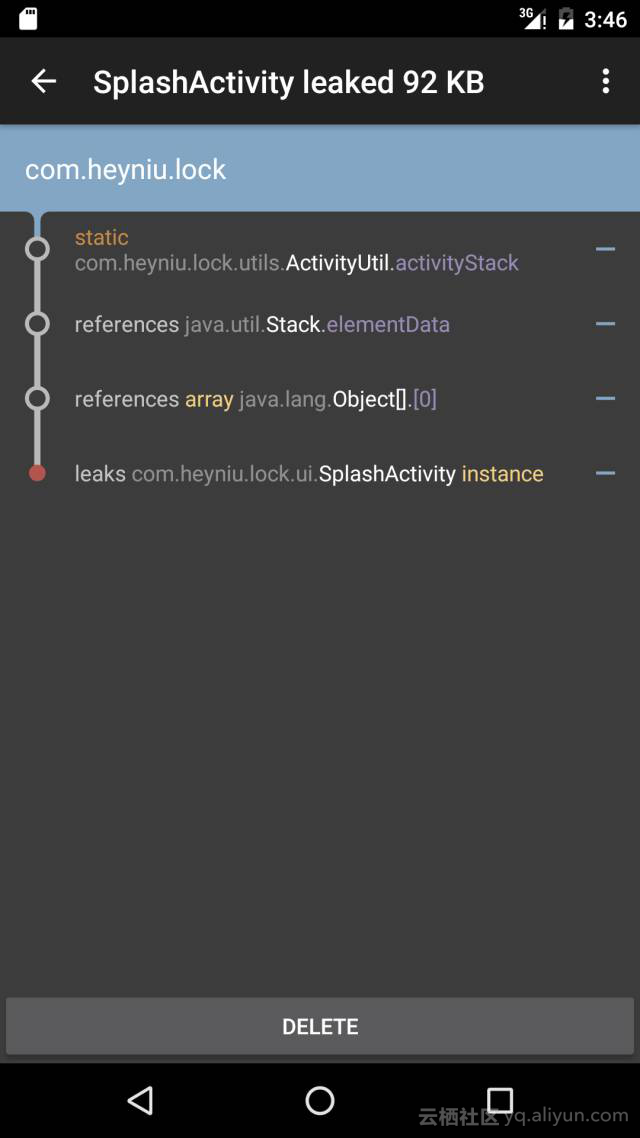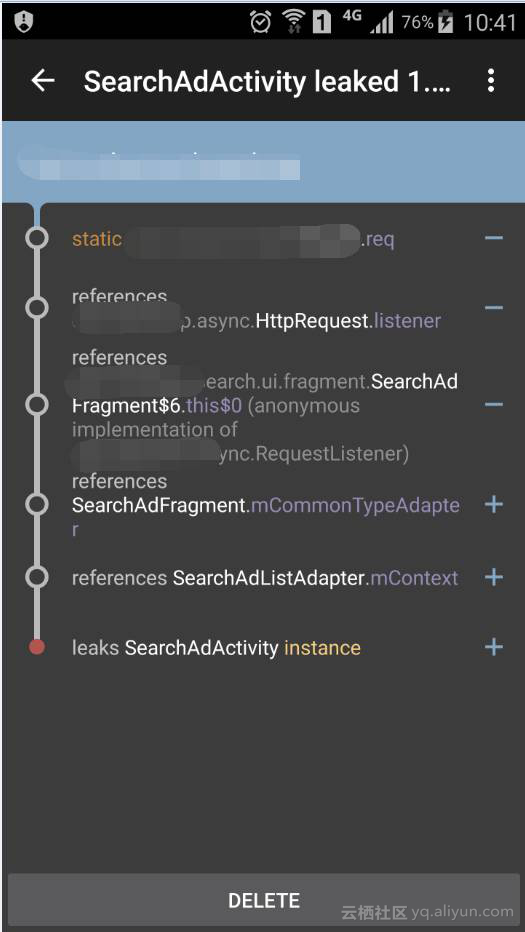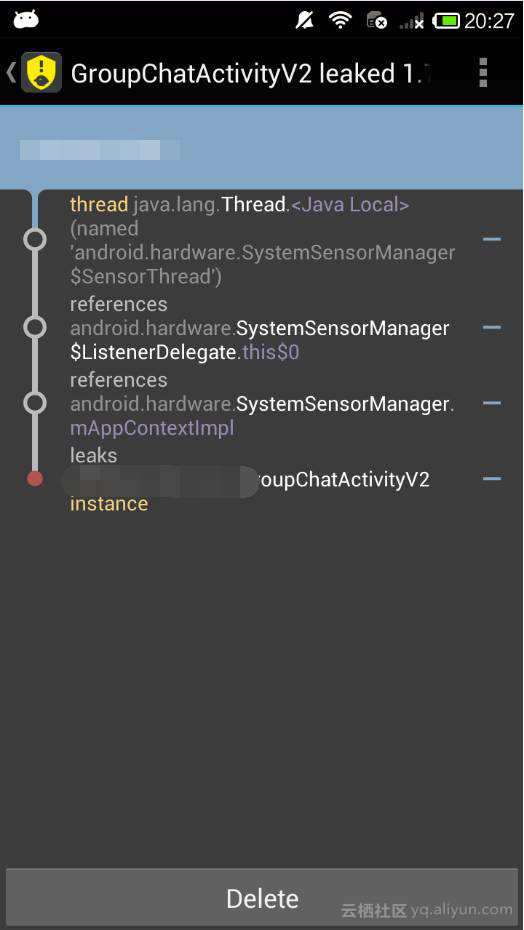定义
内存泄漏也称作 “存储渗漏”,用动态存储分配函数动态开辟的空间,在使用完毕后未释放,结果导致一直占据该内存单元。直到程序结束。(其实说白了就是该内存空间使用完毕之后未回收)即所谓内存泄漏。
内存泄漏形象的比喻是 “操作系统可提供给所有进程的存储空间正在被某个进程榨干”,最终结果是程序运行时间越长,占用存储空间越来越多,最终用尽全部存储空间,整个系统崩溃。所以 “内存泄漏” 是从操作系统的角度来看的。这里的存储空间并不是指物理内存,而是指虚拟内存大小,这个虚拟内存大小取决于磁盘交换区设定的大小。由程序申请的一块内存,如果没有任何一个指针指向它,那么这块内存就泄漏了。
——来自《百度百科》
影响
- 导致 OOM
- 糟糕的用户体验
- 鸡肋的 App 存活率
成效
- 内存泄露是一个持续的过程,随着版本的迭代,效果越明显
- 由于某些原因无法改善的泄露(如框架限制),则尽量降低泄露的内存大小
- 内存泄露实施后的版本,一定要验证,不必马上推行到正式版,可作为 beta 版持续观察是否影响/引发其他功能/问题
内存泄露实施后,项目的收获:
- OOM 减少 30% 以上
- 平均使用内存从 80M 稳定到 40M 左右
- 用户体验上升,流畅度提升
- 存活率上升,推送到达率提升
类型
- IO
- Bitmap
- Context
- Service
- BraodcastReceiver
- ContentObserver
- Handler
- Thread
技巧
| 类型 |
垃圾回收时间 |
生存时间 |
| 强引用 |
永远不会 |
JVM 停止运行时终止 |
| 软引用 |
内存不足时 |
内存不足时终止 |
| 弱引用 |
垃圾回收时 |
垃圾回收时终止 |
| 虚引用 |
垃圾回收时 |
垃圾回收时终止 |
Java 引用介绍(http://blog.csdn.net/mazhimazh/article/details/19752475)
Java 四种引用由高到低依次为:强引用 > 软引用 > 弱引用 > 虚引用
表格说明
-
复用 ConvertView
-
对象释放
- 遵循谁创建谁释放的原则
- 示例:显示调用 clear 列表、对象赋空值
分析
原理
根本原因
怎么解决
实践分析
方案
实践(示例)
Bitmap 泄露
Bitmap 泄露一般会泄露较多内存,视图片大小、位图而定
- 经典场景:App 启动图
- 解决内存泄露前后内存相差 10M+,可谓惊人
- 解决方案:
App 启动图 Activity 的 onDestroy() 中及时回收内存
@Override
protected void onDestroy() {
// TODO Auto-generated method stub
super.onDestroy();
recycleImageView(imgv_load_ad);
}
public static void recycleImageView(View view){
if(view==null) return;
if(view instanceof ImageView){
Drawable drawable=((ImageView) view).getDrawable();
if(drawable instanceof BitmapDrawable){
Bitmap bmp = ((BitmapDrawable)drawable).getBitmap();
if (bmp != null && !bmp.isRecycled()){
((ImageView) view).setImageBitmap(null);
bmp.recycle();
bmp=null;
}
}
}
}
IO 流未关闭
- 分析:通过日志可知 FileOutputStream() 未关闭
- 问题代码:
public static void copyFile(File source, File dest) {
FileChannel inChannel = null;
FileChannel outChannel = null;
Log.i(TAG, "source path: " + source.getAbsolutePath());
Log.i(TAG, "dest path: " + dest.getAbsolutePath());
try {
inChannel = new FileInputStream(source).getChannel();
outChannel = new FileOutputStream(dest).getChannel();
inChannel.transferTo(0, inChannel.size(), outChannel);
} catch (IOException e) {
e.printStackTrace();
}
}
public static void copyFile(File source, File dest) {
FileChannel inChannel = null;
FileChannel outChannel = null;
Log.i(TAG, "source path: " + source.getAbsolutePath());
Log.i(TAG, "dest path: " + dest.getAbsolutePath());
try {
inChannel = new FileInputStream(source).getChannel();
outChannel = new FileOutputStream(dest).getChannel();
inChannel.transferTo(0, inChannel.size(), outChannel);
} catch (IOException e) {
e.printStackTrace();
} finally {
if (inChannel != null) {
try {
inChannel.close();
} catch (IOException e) {
e.printStackTrace();
}
}
if (outChannel != null) {
try {
outChannel.close();
} catch (IOException e) {
e.printStackTrace();
}
}
}
}
E/StrictMode: A resource was acquired at attached stack trace but never released.
See java.io.Closeable for information on avoiding resource leaks.
java.lang.Throwable: Explicit termination method 'close' not called
at dalvik.system.CloseGuard.open(CloseGuard.java:180)
at java.io.FileOutputStream.<init>(FileOutputStream.java:89)
at java.io.FileOutputStream.<init>(FileOutputStream.java:72)
at com.heyniu.lock.utils.FileUtil.copyFile(FileUtil.java:44)
at com.heyniu.lock.db.BackupData.backupData(BackupData.java:89)
at com.heyniu.lock.ui.HomeActivity$11.onClick(HomeActivity.java:675)
at android.support.v7.app.AlertController$ButtonHandler.handleMessage(AlertController.java:157)
at android.os.Handler.dispatchMessage(Handler.java:102)
at android.os.Looper.loop(Looper.java:148)
at android.app.ActivityThread.main(ActivityThread.java:5417)
at java.lang.reflect.Method.invoke(Native Method)
at com.android.internal.os.ZygoteInit$MethodAndArgsCaller.run(ZygoteInit.java:726)
at com.android.internal.os.ZygoteInit.main(ZygoteInit.java:616)
单例模式泄露
- 分析:通过截图我们发现 SplashActivity 被 ActivityUtil 的实例 activityStack 持有
- 引用代码:
ActivityUtil.getAppManager().add(this);
- 持有代码:
public void add(Activity activity) {
if (activityStack == null) {
synchronized (ActivityUtil.class){
if (activityStack == null) {
activityStack = new Stack<>();
}
}
}
activityStack.add(activity);
}
- 解决方案:
- 在 SplashActivity 的 onDestroy() 生命周期移除引用
@Override
protected void onDestroy() {
super.onDestroy();
ActivityUtil.getAppManager().remove(this);
}

静态变量持有 Context 实例泄露
- 分析:长生命周期持有短什么周期引用导致泄露,详见上文四大组件 Context 和 Application 的 context 使用
- 示例引用代码:
private static HttpRequest req;
public static void HttpUtilPost(Context context, int TaskId, String url, String requestBody,ArrayList<HttpHeader> Headers, RequestListener listener) {
// TODO Auto-generated constructor stub
req = new HttpRequest(context, url, TaskId, requestBody, Headers, listener);
req.post();
}
- 解决方案:
- public static void cancel(int TaskId) {
- if(req != null && req.get() != null){
- req.get().AsyncCancel(TaskId);
- }
}
private static WeakReference<HttpRequest> req;public static void HttpUtilPost(Context context, int TaskId, String url, String requestBody,ArrayList<HttpHeader> Headers, RequestListener listener) {
// TODO Auto-generated constructor stub
req = new WeakReference<HttpRequest>(new HttpRequest(context, url, TaskId, requestBody, Headers, listener));
req.get().post();
}
private static HttpRequest req;public static void HttpUtilPost(Context context, int TaskId, String url, String requestBody,ArrayList<HttpHeader> Headers, RequestListener listener) {
// TODO Auto-generated constructor stub
req = new HttpRequest(context.getApplicationContext(), url, TaskId, requestBody, Headers, listener);
req.post();
}
- 改为长生命周期
- 改为弱引用
- pass:弱引用随时可能为空,使用前先判空
- 示例代码:

服务未解绑注册泄露
- 分析:一般发生在注册了某服务,不用时未解绑服务导致泄露
- 引用代码:
private void initSensor() {
// 获取传感器管理器
sm = (SensorManager) container.activity.getSystemService(Context.SENSOR_SERVICE);
// 获取距离传感器
acceleromererSensor = sm.getDefaultSensor(Sensor.TYPE_PROXIMITY);
// 设置传感器监听器
acceleromererListener = new SensorEventListener() {
......
};
sm.registerListener(acceleromererListener, acceleromererSensor, SensorManager.SENSOR_DELAY_NORMAL);
}
- 解决方案:
在 Activity 的 onDestroy() 方法解绑服务
@Override
protected void onDestroy() {
super.onDestroy();
sm.unregisterListener(acceleromererListener,acceleromererSensor);
}

Handler 泄露
- 分析:由于 Activity 已经关闭,Handler 任务还未执行完成,其引用了 Activity 的实例导致内存泄露
- 引用代码:
handler.sendEmptyMessage(0);
- 解决方案:
在 Activity 的 onDestroy() 方法回收 Handler
@Override
protected void onDestroy() {
super.onDestroy();
handler.removeCallbacksAndMessages(null);
}
- 图片后续遇到再补上
异步线程泄露
- 分析:一般发生在线程执行耗时操作时,如下载,此时 Activity 关闭后,由于其被异步线程引用,导致无法被正常回收,从而内存泄露
- 引用代码:
new Thread() {
public void run() {
imageArray = loadImageFromUrl(imageUrl);
}.start();
- 解决方案:
把线程作为对象提取出来
在 Activity 的 onDestroy() 方法阻塞线程
thread = new Thread() {
public void run() {
imageArray = loadImageFromUrl(imageUrl);
};
thread.start();
@Override
protected void onDestroy() {
super.onDestroy();
if(thread != null){
thread.interrupt();
thread = null;
}
}
后面
- 欢迎补充实际中遇到的泄露类型
- 文章如有错误,欢迎指正
- 如有更好的内存泄露分享方法,欢迎一起讨论
未完待续。。。
阿里云测移动质量中心(以下简称 MQC)是为广大企业客户和移动开发者提供真机测试服务的云平台,拥有大量热门机型,提供 7x24 全天候服务。
我们致力于提供专业、稳定、全面、高价值的自动化测试能力,以及简单易用的使用流程、贴心的技术服务,并且帮助客户以最低的成本、最高的效率发现 APP 中的各类隐患(APP 崩溃、各类兼容性问题、功能性问题、性能问题等),减少用户流失,提高 APP 质量和市场竞争力。
联系我们:
网站地址:https://mqc.aliyun.com
开发者交流旺旺群:335334143
开发者交流 QQ 群:492028798
客服邮箱:mqc_group@service.alibaba.com
更多精彩技术分享 欢迎关注 MQC 公众号


↙↙↙阅读原文可查看相关链接,并与作者交流




